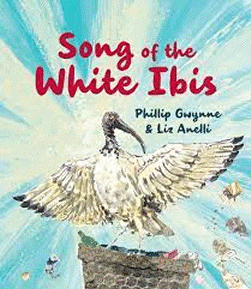
Song of the White Ibis
Song of the White Ibis
Phillip Gwynne
Liz Anelli
Puffin. 2022
32pp., hbk., RRP $A24.99
9781760897949
The ‘chorus” of this song would seem to sum up this bird’s reputation…
Call me Bin Chicken
Call me Tip Turkey
Call me Picnic Pirate
But, in fact, the white ibis – Threskiornis molucca – has a more dignified tale to tell. That of being related to the Sacred Ibis of Egypt and to Thoth, the god of science, writing, magic and the moon; that of being the farmers’ friend as their long beaks aerate the soil as they dig for troublesome insects like locusts; that of once living in the wetlands but driven to being of scavenger of the cities because of human habitation overtaking theirs.
There was much derision when Queensland Tourism Minister Stirling Hinchliffe suggested the white ibis to be the mascot for the 2032 Olympic Games in Brisbane but this intriguing book by Phillip Gwynne with its detailed illustrations from Liz Anelli shows the bird in a completely different light, offering a different side to its common image. Certainly, the final message of “reduce, reuse, recycle’ or we might all become bin chickens is confronting but is a definite heads up to make us think about why there is just so much waste to enable these birds to thrive in the urban environment.
According to the National Food Waste Strategy Feasibility Study …
- Food waste costs the economy around $36.6 billion each year.
- Each year we waste around 7.6 million tonnes of food across the supply and consumption chain – this wastage equals about 312kg per person, equivalent to around one in five bags of groceries or $2,000 to $2,500 per household per year.
- Food waste accounts for approximately 3% of Australia’s annual greenhouse gas emissions.
- Australia uses around 2600 gigalitres of water to grow food that is wasted – this equates to the volume of water in five Sydney Harbours.
- The amount of land used to grow wasted food covers in excess of 25 million hectares, a landmass larger than the state of Victoria.
(Source: Department of Agriculture, Water and the Environment, 2022)
Thus, this book could be the springboard to students investigating food waste and its management in both our schools and our homes making it so much more that a plea from a bird for some dignity and respectability. Even young readers can create visual representations of what 312kg or one in five bags of groceries look like. And that notion of it being the Olympic mascot could be more beneficial than first considered…